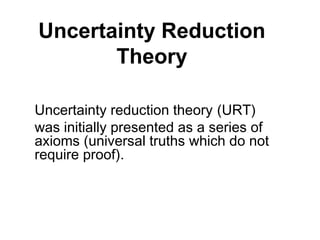
Uncertainty reduction
- 1. Uncertainty Reduction Theory Uncertainty reduction theory (URT) was initially presented as a series of axioms (universal truths which do not require proof).
- 2. • This theory comes from the sociopsycological perspective. It is the basic process of how we gain knowled ge about other people. According to th e theory people have difficulty with unc ertainty, they want to be able to predict behavior and therefore they are motiva ted to seek more information about pe ople.
- 3. • URT was developed to describe the interrelationships between seven important f actors in any dyadic exchange: verbal com munication, nonverbal expressiveness, infor mation-seeking behavior, intimacy, reciproci ty, similarity, and liking. • The theory also says that higher levels of uncertainty create distance between people and that non-verbal expressiveness tends to help reduce uncertainty.
- 4. In the movie, Mona Lisa Smile • Katherine comes to be a new teacher in the university where she doesn’t know anyone. She meets a lot of new people and environment as well as unexpected situation which cause feeling of “uncertainty”. • At first, she is so nervous due to the uncertainty about her new job, colleague, and student. But later, she can apply the uncertainty reduction theory to solve her problem.
- 5. According to the theory, There are three ways to reduce uncertainty
- 6. 1. Passive strategies: observing the person. • For example: In the first class, Katherine tries to observe her student’s character and knowledge level at the same time the student also observe what the teacher is going to do.
- 7. 2. Active strategies: asking others about the person or looking up information. • For example: The student interesting and talking about their teacher then, they invite her to their private party to seek for more information.
- 8. 3. Interactive strategies: asking questions, self- disclosure. • For-example: Katherine starts to show her point of view that anti old tradition housewife. Also, she starts to questing is it appropriate way for teenager women to end up.
